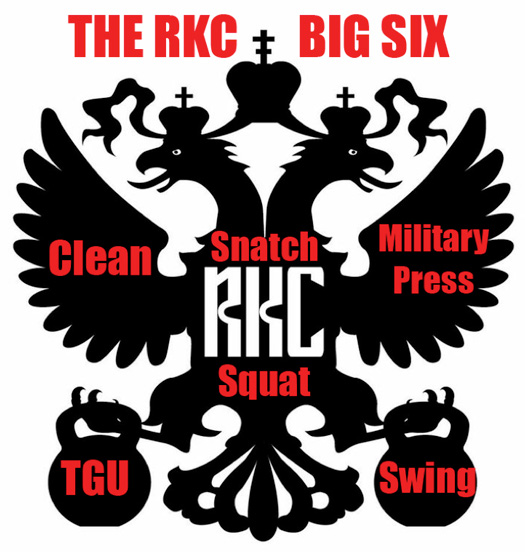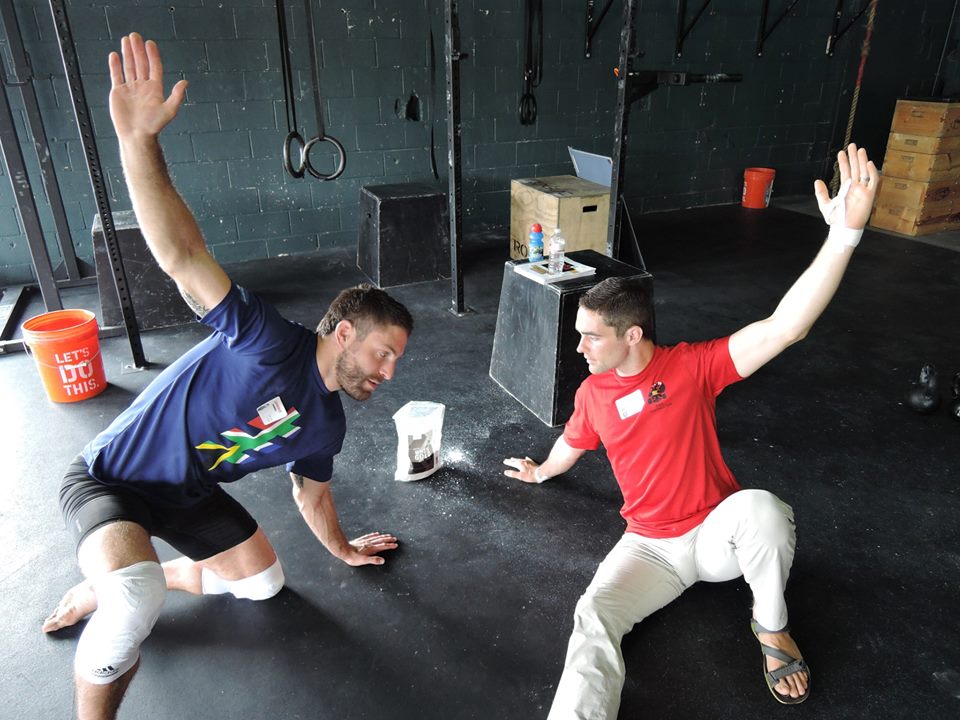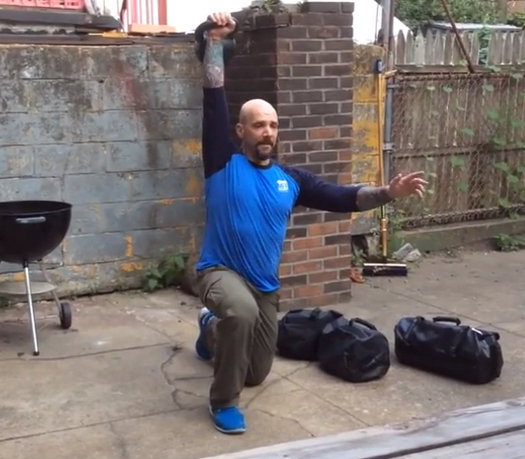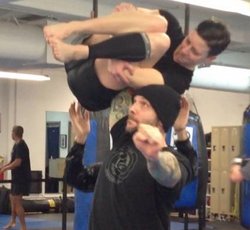
INTRODUCTION
Everyone is looking for the perfect “thing”–the perfect diet, the perfect car, the perfect vacation, the perfect look, the perfect mate (sorry, not going to happen and this isn’t the venue for that conversation), or the perfect workout. Looking to find the “perfect” anything is a fool’s quest but the pursuit of perfection makes champions. This article will explore what I consider to be the almost perfect strength and conditioning program: the Russian Kettlebell Certified (RKC) Kettlebell training system.
PREFIX
To determine if something is “perfect”, you have to either compare it against other similar items or at least have a list of criteria that you can judge it against. Fair enough. In this instance we are looking for the perfect strength and conditioning program and while I’m not going to point fingers or name names, I will define the characteristics that I think make the RKC superior. In my humble opinion for a strength and conditioning program to be anywhere “near perfect” it needs to have (at a minimum) the following components:
- It must address the six basic movement patterns:
- Push
- Pull
- Squat
- Hinge
- Carry
- Groundwork (ex. Turkish Get Up)
- It must have both Ballistics and Grinds as part of the training program:
- a. Ballistics for strength endurance and impact generation
- b. Grinds for deep strength and tenacity under pressure
Those are the basic criteria for analysis and they are pretty easily defined. The goal of the perfect system should be to enhance the athlete’s or client’s overall strength, mobility, work output and athleticism. Read on to find out why I think the RKC meets these criteria and much more.
SWING (Ballistic)
To say that the kettlebell swing is the foundation that all ballistic movements with the kettlebell are based on would be an understatement. The swing establishes a deep and powerful explosive groove that allows the athlete to generate power from the ground up. It reinforces transitional and positional strength skills as well as developing a fine tuned ability to go from absolute relaxation to absolute tension in a heartbeat (one that is beating very fast as well).
Training the kettlebell swing develops the hugely important hinge movement in a dynamic manner. Most athletes will train the hinge, or something that looks like it, while doing barbell deadlifts. But the kettlebell swing gives the athlete a platform to practice exploding out of the hinge, dynamically loading the hinge, and teaches how to transition quickly and efficiently from loading to unloading while seamlessly applying force when and where it is needed. This is a tremendously valuable skill for anyone involved in contact sports or who has to move fast and recover quickly–like Moms and Dads chasing kids around!
GOBLET SQUAT (Grind)
The squat has been the staple of most strength and conditioning programs since before the invention of the barbell–as well it should be. The squat develops tremendous strength in the legs, hamstrings and glutes. It also requires the athlete to establish and maintain bracing throughout the torso. Understanding how to squat well is one of the foundational movement patterns and one that is overlooked by many athletes; you know the ones – big guns and chicken legs. In the RKC System, the goblet squat is the primary squatting movement for a good reason: most people (even those who have been squatting for years) lack the strength, mobility, and awareness to squat safely and effectively.
The goblet squat establishes a solid structure for loading the posterior chain, reinforcing the anterior chain, and creating alignment in the joints that ensures safe loading and transitions. For some, the goblet squat takes on a more rehabilitative form since it trains the client or athlete to open their hips and use their knees safely and effectively while teaching how to avoid undue stress on the lower back. The only drawback of the goblet squat is that it cannot be loaded to the same extent as a barbell squat. The inclusion of the kettlebell squat with one or two kettlebells makes this point almost moot. Once again, you can’t go to extreme loads but the efficiency but efficacy of the squat with the kettlebell almost makes up for it.
TURKISH GET-UP (Grind)
The Turkish get-up (TGU) or just plain old “get-up” is new to this generation of athletes and has found many ardent followers. The TGU is relatively hard to categorize. Some people consider it to be a pure strength technique while others categorize it as a mobility or pre-hab/rehab tool. Regardless, the TGU is an essential tool in the quest to make athletes move better and develop integrated strength. With modest loads, the TGU can be used as a strength endurance tool; the stresses placed on the athlete getting up and down are phenomenal for conditioning and rival the dreaded burpee for the language they generate. With heavier loads, the TGU can be used to develop transitional and positional strength like no other technique that I am aware of. Mastery of a number of planes of movement, the ability to maintain tension and establish intermediate loading and unloading positions, are all challenges that must be overcome if you are going to be successful at doing the TGU. From a pure movement perspective the TGU is golden and adequately fills in the “groundwork” section of the basic movement pattern requirements.
CLEAN (Ballistic)
The kettlebell clean is often overlooked and under-appreciated when it comes to developing strength. But I will tell you this from the outset–show me someone with a weak clean and I will show you someone who has an even weaker snatch and military press. The clean is the foundation for all of the overhead ballistics and grinds with the kettlebell and it also establishes an efficient and powerful groove that will be reflected in the kettlebell snatch. The clean, just like the swing, is a foundational move that relies on a powerful backswing to get the kettlebell moving. But unlike the swing, the clean requires that the kettlebell be directed upward as opposed to outward. A “swingy” clean is ugly and painful as well as being inefficient. Once the kettlebell has been “cleaned” it is considered to be in the “rack”–and that is where the magic happens. The “racked” kettlebell is now being supported by a complex symphony of tension from the anterior and posterior chains and is ready to be cleaned again or (military) pressed or jerked. The stability of the kettlebell in the clean (racked position) has to be absolute if it is going to be used to grind the kettlebell overhead via the military press or as a ballistic via the kettlebell jerk.
MILITARY PRESS (Grind)
The military press (MP) is the first overhead technique in the RKC System. The MP trains full body tension, bracing or “wedging” of the body under the load, efficient grooving (the path the kettlebell takes), the overhead lockout, and much more. More than just a mindless pressing movement with the kettlebell, the MP trains the client or athlete to drive from the ground up to press the kettlebell overhead, hold the lockout, and then to pull the kettlebell back into the racked position of the clean. The last five decades or so has seen the MP being supplanted in most strength and conditioning programs by a heavy emphasis on the bench press. While the bench press has many and varied benefits the MP is (in my opinion) superior to developing integration with the torso and power from the upper torso that translates over to many sporting and daily functions. The MP can be very frustrating for both sexes as well. Men who have a “big bench” find that they have puny MP’s. Women who have strong legs and good kettlebell swings are stymied by trying to get even a light load safely overhead. With a little practice and some determination, both groups will find their strength improve and will reap the benefits of being stronger overhead (especially when it comes time to snatch the kettlebell).
SNATCH (Ballistic)
The kettlebell snatch is a riddle wrapped in an enigma. It looks so easy and effortless when you watched it done by a well trained practitioner and it can also look like a tragedy in the making when done by someone without the proper coaching. As a ballistic technique it is comprised of many facets that appear to be one smooth and seamless movement (if done correctly). I have heard the snatch described as a “swing that ends up overhead” but I don’t think that is an accurate assessment of the movement. The swing is more like a clean that ends up overhead. I’ve always said that a “clean is a short snatch and a snatch is a long clean”. Why? Because the trajectory of the clean and the snatch are almost exactly the same; one ends up on your shoulder and the ends up overhead. But why is the snatch such an important part of the RKC? Because it trains the client or athlete to develop and master a number of skills and make them appear as one.
To master the snatch you have to be able to generate, manage, and absorb force; you need to be able to manage tension and relaxation; you need to be able to create and demonstrate positional and transitional strength; and so much more. Hopefully you can see why the snatch is held in such high regard and considered by some as the “King of the Ballistics”.
CONCLUSION
Six techniques – that’s it. With those six you have met all of the requirements of the six basic movement patterns with the exception of one: the carry. That’s pretty easy to fix with some farmers’ carries or walking with the kettlebell in the clean (racked position) or held overhead. Okay, okay – the pull is somewhat sketchy as well, although you are getting some great pulling work out of all the kettlebell ballistics. The addition of renegade rows or pull ups will fill that gap nicely as well.
Here’s the thing – there is no “perfect” system but the RKC comes darn close to hitting the basic requirements that any client or athlete needs to improve their movement, their athleticism, and their longevity. A nice balance of ballistics and grinds as well as a series of movements that hit every major muscle (and most of the minor ones as well) makes the RKC system “near perfect” as far as a strength and conditioning program goes – and that’s about all you can ask for in this lifetime.
***
About Michael A. Krivka, Sr. – Senior RKC: Michael A. Krivka, Sr. is a Washington, DC native who has been involved in Kettlebell training for over a decade and is currently an RKC Team Leader and member of the RKC Board of Advisors and the RKC Leadership Team under Dragon Door (where he has been listed as one of the top reviewed RKC’s in the world for the last five years). He is also the author of a bestselling eBook entitled “Code Name: Indestructible” and is in the process of finishing up several other eBooks on Kettlebells, body weight, and the integration of other tools into an effective strength and conditioning program. Mike has traveled extensively throughout the United States teaching Russian Kettlebells to military (USMC, USN, USA and USAF) and law enforcement personnel (FBI, DEA, USSS and CIA)… read more here.


 Personally, I find the three hardest parts of a get-up (regardless of weight) to be the initial roll to elbow, the half kneeling to stand and the final roll from elbow to your back. Whether it’s a
Personally, I find the three hardest parts of a get-up (regardless of weight) to be the initial roll to elbow, the half kneeling to stand and the final roll from elbow to your back. Whether it’s a